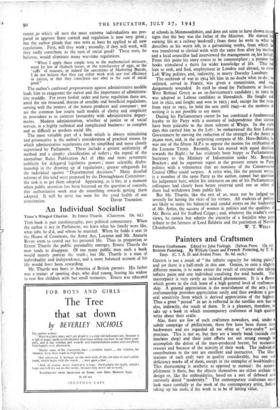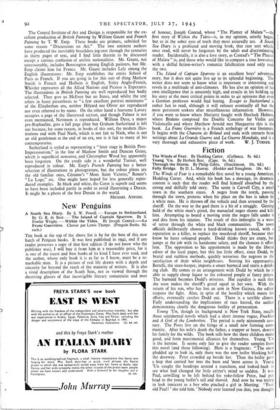Painters and Craftsmen
GENIUS is not a result of " the infinite capacity for taking pains," and yet there is a half-truth in this saw. Genius, to coin a slightly different maxim, is to some extent the result of everyone else taking infinite pains and one individual canalising the total benefit. The masterpiece is very rarely an isolated phenomenon. It is a flower which grows in the rich loam of a high general level of craftsman- ship. A general appreciation is the nourishment of the arts ; fine craftsmanship provokes appreciation easily and thus awakens a gen- eral sensitivity from which is derived appreciation of the highest. Thus a great " period " in art is reflected in the satellite arts but is also, indirectly, the result of them. It is a pleasure, therefore, to take up a book in which contemporary craftsmen of high quality write about their crafts.
Alas, there are few of such craftsmen nowadays, and, under I subtle campaign of philistinism, these few have been thrust into backwaters and are regarded all too often as " arty-crafty " and precious. This is not so, but they are a lonely band (outside the machine shop) and their joint efforts are not strong enough to accomplish the defeat of the mass-produced horror, for economic reasons and because of the scarcity of their work. The individual contributions to the text are excellent and instructive. The illus- trations of each craft vary in quality considerably, but one sad deficiency marks all of them, except in the examples of bookbinding. This shortcoming is aesthetic as opposed to manual: the accom- plishment is there, but the objects themselves are either archaic in design or, like the embroideries, based on a sort of debased and curiously dated "modernity." The contemporary craftsman must look more carefully at the work of the contemporary artist, befo:c taking up his tools, if his work is to be of lasting value. The Central Institute of Art and Design is responsible for the ex- cellent production of British Painting by William Gaunt and French Painting by T. W. Earp. These books are primers, subtitled for some reason " Discussions on Art." The two eminent authors have produced the inevitably breathless jog-trot through the centuries in thirty pages of text, and I find little therein to be discussed except a curious confusion of artistic nationalities. Mr. Gaunt, not unreasonably, includes Bonnington among English painters, but Mr. Earp claims him for France. Mr. Gaunt includes Lely among the English illustrations: Mr. Earp establishes the entire School of Paris as French. If you are going in for this sort of thing Mathew Smith is French and Holbein is English, Sisley Anglo-French, Whistler represents all the Allied Nations and Picasso is Esperanto. The illustrations in British Painting are well reproduced but badly selected. They give us McEvoy but no Innes, and whilst the text refers in hasty parenthesis to " a few excellent portrait miniatures " of the Elizabethan era, neither Hilyard nor Oliver are reproduced nor even referred to by name. On the other hand a fearsome Lavery occupies a page of the illustrated section, and though Palmer is not even mentioned, Nevinson is reproduced. William Dyce, a minor pre-Raphaelite, gets a full page plate but Graham Sutherland is left out because, for some reason, in books of this sort, the modern illus- trations end with Paul Nash, which is not fair to Nash, who is not an old gentleman at the end of an era, nor is it fair to many of his contemporaries. Sutherland is styled as representing a " later stage in British Post- Impressionism," in the line of Mathew Smith and Duncan Grant, which is superficial nonsense, and Christopher Wood has apparently been forgotten. On the credit side is a wonderful Turner, well reproduced in colour. Mr. Earp's French Painting has a better selection of illustrations in photogravure, but the colour plates are the old familiar ones, Cezanne's " Mont Saint Victoire," Renoir's " La Loge," etc. One might have hoped for less generally repro- duced examples. In black and white, the Corot is superb and seems to have been included partly in order to avoid illustrating a Derain. It might be a photo of the best Derain in the world.
MICHAEL. AYRTON.



























 Previous page
Previous page